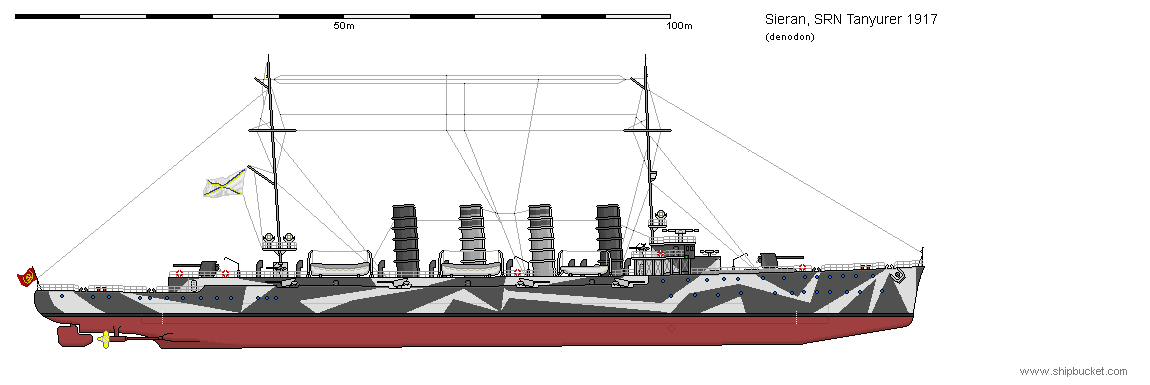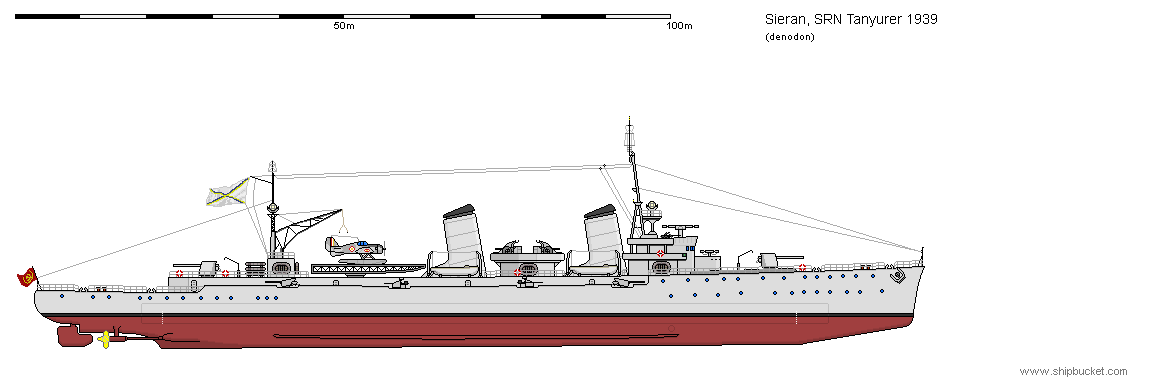Ships of the class;
– SRN Tanyurer (in commission)
– SRN Belaya (in commission)
– SRN Velikaya (cancelled before construction began, became lead ship of the later Velikaya class)
The Tanyurer class of cruisers were the first wholly designed and constructed cruisers for the SRN and were easily identified by their tall masts and four funnels as well as their sleek profile. Designed to counter the construction of the Chikuma class cruisers of the IJN, the Tanyurers were intended to serve as scouts for the fleet during major engagements as well as to sink enemy merchant shipping, using their high speed to outrun potential enemies.
The resulting class was armed with 12 4in quick firing guns arranged two side by side fore and aft and 4 along either side behind bulwarks. 6in guns were originally intended but Naval Hall intervened and selected the 4in for its rate of fire, ease of handling by crews of both gun and ammunition as well as it’s ease of manufacture. The guns were operated under local control with a rangefinder mounted above the bridge to assist the sailors when long range gunnery was required (considered unlikely at the time). The ships were also fitted with submerged torpedo tubes, one on either side below the bridge with a total of five torpedoes. In practice these proved difficult to reload and were rarely used.
Amour for the ships was kept to a minimum. They were fitted with a 2.4in main waterline belt which tapered to 0.6in at the ends. Originally thicker armour was planned but speed took preference and in order to allow for the machinery in the designs displacement, the armour was reduced. The forward conning tower was protected by 4in armour but in reality was little used by the command crew, preferring to be seen as taking equal risk as their men and fighting in the main semi-enclosed bridge. Deck armour consisted of 2.3in over the machinery spaces to protect them from plunging shells.
The Tanyurers were powered by twin steam turbines producing 30,000 rated shaft power with steam provided by 12 water tube coal-fired boilers. Typical max sustained speed was 27 knots but in trials both Tanyurer and Belaya reached 43,000shp and 30 knots for brief periods. This speed advantage was to be used in case of encounters with the Chikumas, allowing the Sieranian vessels to retreat or otherwise dictate the terms of battle. Range was 6,600nm at 12 knots, more than suitable for the ships intended areas of operation. This was to prove just as well as re-coaling of the ships whilst underway proved hazardous and was rarely performed.
The class saw action during the First World War against assets of Imperial Germany. Their speed was satisfactory but it was discovered that their performance in a rough seaway was acceptable but not remarkable. With their shallow draught and lack of bilge keels, the vessels tended to make leeway when confronted with strong winds and also proved sluggish in low speed maneuvers.
Post war, the ships were laid up for a time, their machinery worn from 4 years of continuous service. In 1932 Tanyurer was taken in for a refit and reconstruction which radically altered the ships appearance as well as fitting them with ASW and AA equipment. She was also fitted with a float plane and crane for a time but this was removed by 1940 due to impracticality. Belaya was also rebuilt in 1934 but did not have the same extensive rebuild as her sister, allowing the ships to be distinguished with ease.
By 1939 the class were still in service, their role now being as submarine and aircraft screens for the battleships where they still had decent speed for the role. Whilst outmatched and outgunned by more modern designs, the crews of the Tanyurers are famous in Sieran for their demonstrated courage and ambition. In fleet exercises the crews have continuously shown that they are no foe to be taken lightly.

With the declaration of war against the German Empire, the SRN mobilized all its suitable fleet units for action against the kaisers surface fleet and his submarines. Tanyurer saw service in the North Sea and Atlantic during 1915-16. During this time she was refitted with new directors and had four of her 4in guns replaced with 6in singles fore and aft as she had originally been designed. Four 40mmauto cannons were also fitted for anti air defense primarily against zeppelins, two mounted either side abaft of the bridge and two aside the mainmast. Whilst the new armament were effective, artillery spotters found it difficult to distinguish between the fall of shot for the 6in and 4in guns.
The Tanyurer saw service primarily as a scout and later a convoy escort though she also spent a brief period serving as a Q ship, two of her funnels painted the same colour as her dazzle scheme to obscure them from a distance. Crews also took to concealing her weapons behind canvas awnings that could be quickly removed once a suspected merchant raider revealed herself or a submarine surfaced for an easy kill.

During the rebuild the forward superstructure was almost entirely rebuilt with only the armored conning tower remaining. Her original lofty masts were replaced by a simple pole signal mast and a lattice derrick support structure. Her four funnels were merged into two larger stacks though the lack of interior space meant that moving the original uptakes was almost impossible. A single centrally pivoting catapult was fitted aft of the rear funnel however no hangar was provided, leaving the aircraft exposed to the weather; a less than suitable arrangement. Finally (and out of sight in the drawing) she and her sister recieved new boilers and turbines which gave them once again a considerable speed advantage despite their light armament and negligible protection. Being pre-WW1 hulls, their hulls are beginning to suffer after years of abuse from both the North Pacific storms and aggressive crews pushing them too hard in bad sea conditions.

—
SRN Tanyurer, Socialist Republic of Sieran Tanyurer Class Cruiser laid down 1912
Displacement:
3,537 t light; 3,657 t standard; 4,307 t normal; 4,826 t full load
Dimensions: Length (overall / waterline) x beam x draught (normal/deep)
(445.52 ft / 435.00 ft) x 42.00 ft x (15.00 / 16.43 ft)
(135.79 m / 132.59 m) x 12.80 m x (4.57 / 5.01 m)
Armament:
4 – 4.00″ / 102 mm 50.0 cal guns – 33.88lbs / 15.37kg shells, 150 per gun
Quick firing guns in deck mounts, 1912 Model
2 x Single mounts on centreline, forward deck forward
2 x Single mounts on centreline, aft deck aft
2 raised mounts
8 – 4.00″ / 102 mm 50.0 cal guns – 33.88lbs / 15.37kg shells, 150 per gun
Quick firing guns in deck mounts, 1912 Model
8 x Single mounts on sides, evenly spread
Weight of broadside 407 lbs / 184 kg
Main Torpedoes
5 – 21.0″ / 533 mm, 16.25 ft / 4.95 m torpedoes – 1.049 t each, 5.245 t total
submerged side tubes
Armour:
– Belts: Width (max) Length (avg) Height (avg)
Main: 2.40″ / 61 mm 310.00 ft / 94.49 m 7.78 ft / 2.37 m
Ends: 0.60″ / 15 mm 35.00 ft / 10.67 m 7.78 ft / 2.37 m
90.00 ft / 27.43 m Unarmoured ends
Main Belt covers 110 % of normal length
– Armoured deck – single deck:
For and Aft decks: 2.30″ / 58 mm
– Conning towers: Forward 4.00″ / 102 mm, Aft 0.00″ / 0 mm
Machinery:
Coal fired boilers, steam turbines,
Geared drive, 2 shafts, 30,000 shp / 22,380 Kw = 27.19 kts
Range 6,600nm at 12.00 kts
Bunker at max displacement = 1,169 tons (100% coal)
Complement:
265 – 345
Cost:
£0.330 million / $1.319 million
Distribution of weights at normal displacement:
Armament: 91 tons, 2.1 %
– Guns: 81 tons, 1.9 %
– Weapons: 10 tons, 0.2 %
Armour: 707 tons, 16.4 %
– Belts: 240 tons, 5.6 %
– Armour Deck: 444 tons, 10.3 %
– Conning Tower: 23 tons, 0.5 %
Machinery: 1,316 tons, 30.6 %
Hull, fittings & equipment: 1,423 tons, 33.0 %
Fuel, ammunition & stores: 769 tons, 17.9 %
Miscellaneous weights: 0 tons, 0.0 %
Overall survivability and seakeeping ability:
Survivability (Non-critical penetrating hits needed to sink ship):
5,075 lbs / 2,302 Kg = 158.6 x 4.0 ” / 102 mm shells or 1.1 torpedoes
Stability (Unstable if below 1.00): 1.27
Metacentric height 2.1 ft / 0.6 m
Roll period: 12.2 seconds
Steadiness – As gun platform (Average = 50 %): 78 %
– Recoil effect (Restricted arc if above 1.00): 0.19
Seaboat quality (Average = 1.00): 1.55
Hull form characteristics:
Hull has rise forward of midbreak, low quarterdeck ,
a normal bow and a cruiser stern
Block coefficient (normal/deep): 0.550 / 0.563
Length to Beam Ratio: 10.36 : 1
‘Natural speed’ for length: 20.86 kts
Power going to wave formation at top speed: 56 %
Trim (Max stability = 0, Max steadiness = 100): 50
Bow angle (Positive = bow angles forward): 13.10 degrees
Stern overhang: 4.70 ft / 1.43 m
Freeboard (% = length of deck as a percentage of waterline length):
Fore end, Aft end
– Forecastle: 15.51 %, 25.00 ft / 7.62 m, 21.50 ft / 6.55 m
– Forward deck: 15.05 %, 21.50 ft / 6.55 m, 20.50 ft / 6.25 m
– Aft deck: 50.94 %, 16.00 ft / 4.88 m, 15.50 ft / 4.72 m
– Quarter deck: 18.50 %, 12.00 ft / 3.66 m, 13.00 ft / 3.96 m
– Average freeboard: 17.05 ft / 5.20 m
Ship space, strength and comments:
Space – Hull below water (magazines/engines, low = better): 108.0 %
– Above water (accommodation/working, high = better): 155.3 %
Waterplane Area: 12,750 Square feet or 1,185 Square metres
Displacement factor (Displacement / loading): 121 %
Structure weight / hull surface area: 64 lbs/sq ft or 311 Kg/sq metre
Hull strength (Relative):
– Cross-sectional: 0.93
– Longitudinal: 1.96
– Overall: 1.00
Adequate machinery, storage, compartmentation space
Excellent accommodation and workspace room
Ship has slow, easy roll, a good, steady gun platform
Excellent seaboat, comfortable, can fire her guns in the heaviest weather